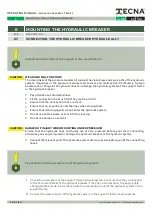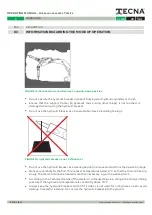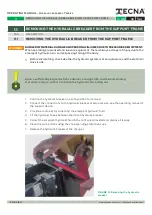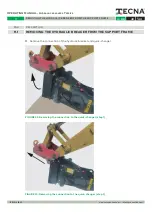
www.tecnaonline.com - [email protected]
E N G L I S H
9
TOOL
PAR
DESCRIPTION
9.1
TOOL
Selecting the correct tool best-suited for a particular application is of great importance not only with
respect to an increase in productivity of the hydraulic breaker but also with respect to the service life of
the tool itself.
The hydraulic breakers are available with a range of specially-designed tools.
Here is a description of the most widely used tools for the most common jobs; customers can feel free
to contact our Technical Department for special cases in order to find suitable solutions for any possible
problems that may crop up or for specific problems. The preferences of the user, the type of machine
and the special working conditions can also influence this choice.
The following overview serves as general information.
TABLE 2 - Tool
Chisel tool
Moil point tool
Blunt tool
Method
Penetrate and break
Method
Penetrate and break
Method
Knock and break
Suitable for all kinds of digging or
narrow trenching on soft/medium
stratified rocks
Suitable for fine/medium-concrete
demolition or soft, non-stratified
rocks. Secondary breaking of hard
and very hard blocks.
Suitable for fine/medium-concrete
demolition or soft, non-stratified
rocks. Secondary breaking of hard
and very hard blocks.
Examples
•
Sandstone and soft
metamorphous stone
•
Concrete demolition
•
Trenching
•
Roadwork
•
Frozen floor
•
Compacted soil
Examples
•
Sandstone and soft
metamorphous stone
•
Concrete demolition
•
Trenching
•
Tunnel construction
•
Roadwork
Examples
•
Granite and hard metamorphous
stone
•
Concrete demolition
•
Crushing boulders
•
Tunnel construction
•
Roadwork
OPERATING MANUAL
-
H
ydraulic
breakers
T
series
32
/44
REV
0.0
TOOL
9














































